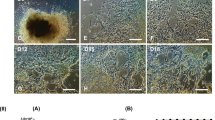Summary
To establish a method of directional differentiation and efficient production of neurons from embryonic stem cells (ES cells)in vitro, based on the 4-/4+ protocol described by Bain, a new method was established to induce ES cells differentiating into neurons by means of three-step differentiation using all-trans retinoic acid (ATRA) combined with astrocyte-conditioned medium (ACM)in Vitro. The totipotency of ES cells was identified by observation of cells morphology and formations of teratoma in immunocompromised mice. The cells differentiation was evaluated continuously by the detection of the specific cellular markers of neural stem cells, neurons and astrocytes, including nestin, NSE and GFAP using immunohistochemistry assay. The NSE positive cells' ratio of the differentiated cells was determined by flow cytometry. It was found that the transparent circular clusters surrounding embryoid bodies induced with combining induction protocol formed just after 24 h and gradually enlarged later. This phenomenon could not be observed in EBs induced only by ATRA. The NSE positive cells' ratio in the cells induced with ATRA and ACM was higher than that of the cells induced by ATRA at different time points of differentiation, and finally reached up to 73.5% among the total differentiated population. It was concluded that ES cells could be induced into neurons with high purity and yield by means of inducing method combining with ATRA and ACM.
Similar content being viewed by others
References
Galvin K A, Jones D G. Adult human neural stem cells for cell-replacement therapies in the central nervous system. MJA, 2002, 177: 316
Reubinoff B E, Pera M F, Fong C Yet al. Embryonic stem cell lines from human blastocysts: somatic differentiationin Vitro. Nature Biotech, 2000, 18: 399
Okada Y, Shimazaki T, Sobue Get al. Retinoic-acidconcentration-dependent acquisition of neural cell identity duringin Vitro differentiation of mouse embryonic stem cells. Dev Biol, 2004, 275: 124
Guan K, Chang H, Rolletschek Aet al. Embryonic stem cell-derived neurogenesis retinoic acid induction and lineage selection of neuronal cells. Cell Tissue Res, 2001, 305: 171
Arvidsson A, Collin T, Kirik Det al. Neuronal replacement from endogenous precursors in the adult brain after stroke. Nat Med, 2002, 8: 963–970
Romanko M J, Rothstein R P, Levison S W. Neural stem cells in the subventricular zone are resilient to hypoxia/ischemia whereas progenitors are vulnerable. JCBM, 2004, 24: 814
Sally T. The development of neural stem cells. Nature, 2001, 414: 112
Song H, Stevens C F, Gage F H. Astroglia induce neurogenesis from adult neural stem cells. Nature, 2002, 417: 39
Author information
Authors and Affiliations
Corresponding author
Additional information
ZHOU Yufeng, male, born in 1974, Doctor in Charge
Rights and permissions
About this article
Cite this article
Yufeng, Z., Feng, F., Yongsui, D. et al. An improved method for directional differentiation and efficient production of neurons from embryonic stem cellsin vitro. Current Medical Science 25, 13–16 (2005). https://doi.org/10.1007/BF02831374
Received:
Published:
Issue Date:
DOI: https://doi.org/10.1007/BF02831374




